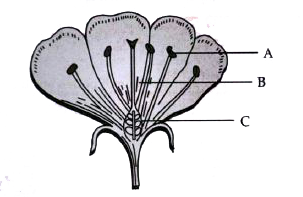Functional part of DNA is called euchromatin, while non-functional part is called heterochromatin.
The correct Answer is:True
Step-by-Step Solution:
1. Understanding Chromatin Structure:
- Chromatin is the complex of DNA and proteins found in the nucleus of eukaryotic cells. It exists in two forms: euchromatin and heterochromatin.
2. Defining Euchromatin:
- Euchromatin is the functional part of DNA. It is less condensed, allowing for easier access to the genetic information. This makes it actively involved in transcription, the process where DNA is copied into RNA.
3. Characteristics of Euchromatin:
- Euchromatin appears darkly stained under a microscope due to its loose structure, which allows for better staining. It is primarily located towards the periphery of the nucleus.
4. Defining Heterochromatin:
- Heterochromatin, on the other hand, is the non-functional part of DNA. It is more condensed and tightly packed, which makes it inactive in terms of transcription.
5. Characteristics of Heterochromatin:
- Heterochromatin appears lightly stained under a microscope because of its dense structure. It is mostly found towards the center of the nucleus and does not participate in the transcription process.
6. Conclusion:
- In summary, euchromatin is the functional part of DNA that is actively involved in transcription, while heterochromatin is the non-functional part that is inactive in transcription.
- Chromatin is the complex of DNA and proteins found in the nucleus of eukaryotic cells. It exists in two forms: euchromatin and heterochromatin.
- Euchromatin is the functional part of DNA. It is less condensed, allowing for easier access to the genetic information. This makes it actively involved in transcription, the process where DNA is copied into RNA.
- Euchromatin appears darkly stained under a microscope due to its loose structure, which allows for better staining. It is primarily located towards the periphery of the nucleus.
- Heterochromatin, on the other hand, is the non-functional part of DNA. It is more condensed and tightly packed, which makes it inactive in terms of transcription.
- Heterochromatin appears lightly stained under a microscope because of its dense structure. It is mostly found towards the center of the nucleus and does not participate in the transcription process.
- In summary, euchromatin is the functional part of DNA that is actively involved in transcription, while heterochromatin is the non-functional part that is inactive in transcription.
Topper's Solved these Questions
- CELL : THE UNIT OF LIFE BOOK - MODERN PUBLICATIONCHAPTER - CELL : THE UNIT OF LIFE EXERCISE - QUICK MEMORY TEST (B. Complete the missing links )
25 Videos
- CELL : THE UNIT OF LIFE BOOK - MODERN PUBLICATIONCHAPTER - CELL : THE UNIT OF LIFE EXERCISE - QUICK MEMORY TEST (C. Choose the correct alternative )
14 Videos
- CELL : THE UNIT OF LIFE BOOK - MODERN PUBLICATIONCHAPTER - CELL : THE UNIT OF LIFE EXERCISE - HIGHER ORDER THINKING SKILLS & BRAIN TWISTING ( LONG ANSWER QUESTIONS )
3 Videos
- BREATHING AND EXCHANGE OF GASESBOOK - MODERN PUBLICATIONCHAPTER - BREATHING AND EXCHANGE OF GASESEXERCISE - CHAPTER PRACTICE TEST
14 Videos
- CELL CYCLE AND CELL DIVISIONBOOK - MODERN PUBLICATIONCHAPTER - CELL CYCLE AND CELL DIVISIONEXERCISE - CHAPTER PRACTICR TEST (SECTION-D)(LONG ANSWER TYPE QUESTION)
1 Videos
Similar Questions
Knowledge Check
Non-functional stamens are called
AAssessory stamensBStaminodesCSupplementary stamensDStaminatesThe functional unit of nature is called
ACommunityBEcosystemCPopulationDSuccessionThe study of functional anatomy is called :
AtectologyBanalogyChomologyDhistology

